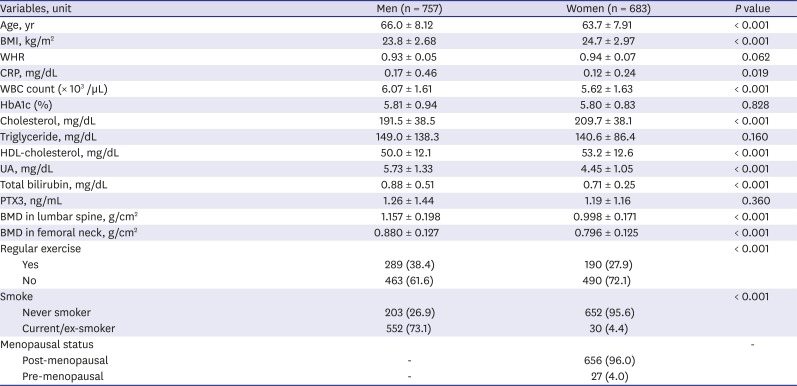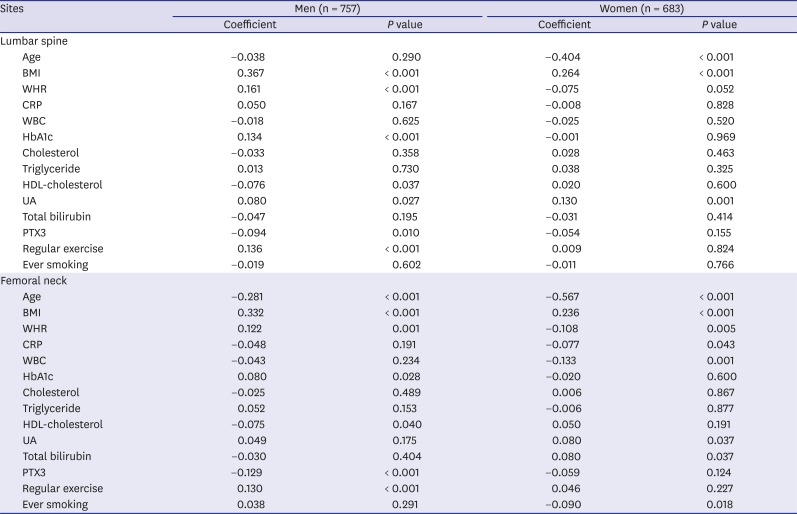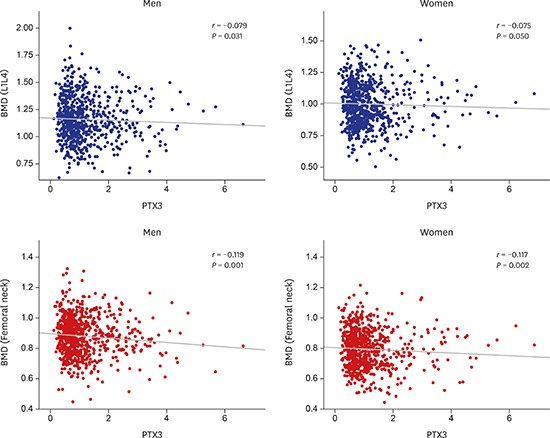1. Looker AC, Wahner HW, Dunn WL, Calvo MS, Harris TB, Heyse SP, et al. Updated data on proximal femur bone mineral levels of US adults. Osteoporos Int. 1998; 8(5):468–489. PMID:
9850356.
2. Iki M, Kagamimori S, Kagawa Y, Matsuzaki T, Yoneshima H, Marumo F. Bone mineral density of the spine, hip and distal forearm in representative samples of the Japanese female population: Japanese Population-Based Osteoporosis (JPOS) Study. Osteoporos Int. 2001; 12(7):529–537. PMID:
11527049.
3. Cheng XG, Yang DZ, Zhou Q, Zhuo TJ, Zhang HC, Xiang J, et al. Age-related bone mineral density, bone loss rate, prevalence of osteoporosis, and reference database of women at multiple centers in China. J Clin Densitom. 2007; 10(3):276–284. PMID:
17604665.
4. Park EJ, Joo IW, Jang MJ, Kim YT, Oh K, Oh HJ. Prevalence of osteoporosis in the Korean population based on Korea National Health and Nutrition Examination Survey (KNHANES), 2008–2011. Yonsei Med J. 2014; 55(4):1049–1057. PMID:
24954336.
5. Ock M, Han JW, Lee JY, Kim SH, Jo MW. Estimating quality-adjusted life-year loss due to noncommunicable diseases in Korean adults through to the year 2040. Value Health. 2015; 18(1):61–66. PMID:
25595235.
6. de Pablo P, Cooper MS, Buckley CD. Association between bone mineral density and C-reactive protein in a large population-based sample. Arthritis Rheum. 2012; 64(8):2624–2631. PMID:
22487938.
7. Romas E, Martin TJ. Cytokines in the pathogenesis of osteoporosis. Osteoporos Int. 1997; 7(Suppl 3):S47–S53. PMID:
9536302.
8. Jenny NS, Arnold AM, Kuller LH, Tracy RP, Psaty BM. Associations of pentraxin 3 with cardiovascular disease and all-cause death: the Cardiovascular Health Study. Arterioscler Thromb Vasc Biol. 2009; 29(4):594–599. PMID:
19164811.
9. Farhat GN, Cauley JA. The link between osteoporosis and cardiovascular disease. Clin Cases Miner Bone Metab. 2008; 5(1):19–34. PMID:
22460842.
10. Stewart TL, Ralston SH. Role of genetic factors in the pathogenesis of osteoporosis. J Endocrinol. 2000; 166(2):235–245. PMID:
10927613.
11. Kweon SS, Shin MH, Jeong SK, Nam HS, Lee YH, Park KS, et al. Cohort profile: The Namwon Study and the Dong-gu Study. Int J Epidemiol. 2014; 43(2):558–567. PMID:
23505254.
12. Shin MH, Zmuda JM, Barrett-Connor E, Sheu Y, Patrick AL, Leung PC, et al. Race/ethnic differences in associations between bone mineral density and fracture history in older men. Osteoporos Int. 2014; 25(3):837–845. PMID:
24146094.
13. Nam HS, Kweon SS, Choi JS, Zmuda JM, Leung PC, Lui LY, et al. Racial/ethnic differences in bone mineral density among older women. J Bone Miner Metab. 2013; 31(2):190–198. PMID:
23143509.
14. Doni A, Garlanda C, Mantovani A. Innate immunity, hemostasis and matrix remodeling: PTX3 as a link. Semin Immunol. 2016; 28(6):570–577. PMID:
27881292.
15. Garlanda C, Bottazzi B, Moalli F, Deban L, Molla F, Latini R, et al. Pentraxins and atherosclerosis: the role of PTX3. Curr Pharm Des. 2011; 17(1):38–46. PMID:
21226667.
16. Lim HS, Park YH, Kim SK. Relationship between serum inflammatory marker and bone mineral density in healthy adults. J Bone Metab. 2016; 23(1):27–33. PMID:
26981518.
17. Milner CM, Higman VA, Day AJ. TSG-6: a pluripotent inflammatory mediator? Biochem Soc Trans. 2006; 34(Pt 3):446–450. PMID:
16709183.
18. Salustri A, Garlanda C, Hirsch E, De Acetis M, Maccagno A, Bottazzi B, et al. PTX3 plays a key role in the organization of the cumulus oophorus extracellular matrix and in in vivo fertilization. Development. 2004; 131(7):1577–1586. PMID:
14998931.
19. Lee TH, Klampfer L, Shows TB, Vilcek J. Transcriptional regulation of TSG6, a tumor necrosis factor- and interleukin-1-inducible primary response gene coding for a secreted hyaluronan-binding protein. J Biol Chem. 1993; 268(9):6154–6160. PMID:
8454591.
20. Zanello LP, Norman AW. 1 alpha,25(OH)2 vitamin D3-mediated stimulation of outward anionic currents in osteoblast-like ROS 17/2.8 cells. Biochem Biophys Res Commun. 1996; 225(2):551–556. PMID:
8753799.
21. Dahl K, Ahmed LA, Joakimsen RM, Jørgensen L, Eggen AE, Eriksen EF, et al. High-sensitivity C-reactive protein is an independent risk factor for non-vertebral fractures in women and men: The Tromsø Study. Bone. 2015; 72:65–70. PMID:
25460573.
22. Sponholtz TR, Zhang X, Fontes JD, Meigs JB, Cupples LA, Kiel DP, et al. Association between inflammatory biomarkers and bone mineral density in a community-based cohort of men and women. Arthritis Care Res (Hoboken). 2014; 66(8):1233–1240. PMID:
24375982.
23. Lee Y, Kim M, Choi K, Kim J, Bae W, Kim S, et al. Relationship between inflammation biomarkers, antioxidant vitamins, and bone mineral density in patients with metabolic syndrome. Nutr Res Pract. 2011; 5(2):150–156. PMID:
21556229.
24. Liu G, Peacock M, Eilam O, Dorulla G, Braunstein E, Johnston CC. Effect of osteoarthritis in the lumbar spine and hip on bone mineral density and diagnosis of osteoporosis in elderly men and women. Osteoporos Int. 1997; 7(6):564–569. PMID:
9604053.
25. Orwoll ES, Oviatt SK, Mann T. The impact of osteophytic and vascular calcifications on vertebral mineral density measurements in men. J Clin Endocrinol Metab. 1990; 70(4):1202–1207. PMID:
2318940.
26. Cauley JA, Barbour KE, Harrison SL, Cloonan YK, Danielson ME, Ensrud KE, et al. Inflammatory markers and the risk of hip and vertebral fractures in men: the Osteoporotic Fractures in Men (MrOS). J Bone Miner Res. 2016; 31(12):2129–2138. PMID:
27371811.
27. Barbour KE, Boudreau R, Danielson ME, Youk AO, Wactawski-Wende J, Greep NC, et al. Inflammatory markers and the risk of hip fracture: the Women’s Health Initiative. J Bone Miner Res. 2012; 27(5):1167–1176. PMID:
22392817.
28. Stojanović D, Bůžková P, Mukamal KJ, Heckbert SR, Psaty BM, Fink HA, et al. Soluble inflammatory markers and risk of incident fractures in older adults: the Cardiovascular Health Study. J Bone Miner Res. 2018; 33(2):221–228. PMID:
28976598.
29. den Uyl D, van Schoor NM, Bravenboer N, Lips P, Lems WF. Low grade inflammation is associated with lower velocity of sound and broadband ultrasound attenuation in older men, but not with bone loss or fracture risk in a longitudinal aging study. Bone. 2015; 81:270–276. PMID:
26188108.








 PDF
PDF Citation
Citation Print
Print




 XML Download
XML Download